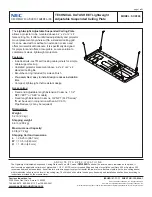
D*AP8
3
Introduction
The
D*AP8
is a generic platform with several software options that can be accomplished by an optional
X*AP RM
1
remote panel. The bundle is designed to allow the operator a direct access to major functions and
important parameters.
It is available as
D*AP8 TAP EDITION
that replaces the former
T*AP
(Television Audio Processor).
While the
D*AP8 FLX EDITION
can be combined to the customer needs at the moment of ordering but can
later be upgraded in the field with more options. Similar applies to the
D*AP8 CODEC
edition that is focused
on
Dolby
encoding / decoding. All three editions are covered by this manual and the MEI (Multi Edition
Image) firmware image. Depending on the licensed features you may not have all functions available.
A special version, the
D*AP8 MAP EDITION
is also available to suite the special needs of monitoring. It is the
successor of the
Dolby DP570
Multi Channel Audio Tool and has its own manual.
For level and loudness measurement and logging applications the
D*AP8
may be used as a measurement
box that sits close to the signal sources while measurement data will be streamed over the network to a PC
for live display and/or storing of such data.
The heard of the
D*AP8
is a sophisticated audio processor. It renders all functions of the audio blocks, as
well as level and loudness measurements.
A comprehensive
Dolby
subsystem including a stand alone metadata generator is provided for optional
decoding, emulation and encoding. The influence of metadata on PCM audio signals can be monitored
either directly from the monitoring section of a mixing console or from a decoded Dolby E stream. It allows
you to hear how the metadata will influence the listening experience on the customers side without insertion
of a consumer format encoder / decoder. The metadata emulation part incorporates a
Dolby
stream
decoder. An optional
Dolby Digital/Digital plus
or a
Dolby-E
encoder can be added to the device.
The four
AES3id I/Os
on the motherboard may be complemented by a variety of interface modules that can
be installed as an option into the
D*AP8
interface slots.
Comprehensive routing set-ups allow almost every signal flow from hardware inputs, from and to optional
Dolby
decoder / encoder, from the audio processor itself to hardware outputs as well as the metadata I/Os,
the metadata generator and the metadata emulator.
Routing paths, the enabling and disabling of audio processing blocks and the setting of processing
parameters can be pre-configured by individual
presets
dedicated to each function block. The content of the
presets
can be displayed and edited off-line while the device is on duty. These
presets
may either be
recalled on demand by the operator via the GUI, the
X*AP RM
1
remote panel hot keys or external systems,
but may also be part of complex scenarios defined by the administrator and automatically executed by the
event manager of the device or by operator intervention.
The
D*AP8
provides a web based setup GUI and can be controlled by an
X*AP RM
1
remote panel that
displays status and metering information and allows user intervention.
Junger Audios application manager
J*AM
is available as an add on and can be attached with a few simple
clicks to the
D*AP8
so that users can log loudness data as well as display it as a live plot on a PC screen in
real time or simply display level bar graphs and numeric loudness values. For production / post-production
needs a built-in LTC reader will be available in the near future. So loudness logging may then be performed in
regard to relative time as well as to time of day.
Completing the feature set of the
D*AP8
is the availability of an
SNMP
agent, which provides traps and status
polling.
As with most advanced tools, the
D*AP8
can be driven in a variety of ways, depending on requirements
and ideas of the user. These can range from simple and straightforward to quite complex set ups.
Although this manual explains the functions and general operation of the
D*AP8
, it does not give detailed
scenarios because the operational needs of today’s broadcasters vary so widely between organizations and
their work flows and cover so many different parameters – from ingest to studio operation, from master
control rooms to play-out, or even rebroadcast applications.
Junger Audio is more than happy to discuss your particular requirements with you and to convey your ideas
and solutions to other users of the
Junger Audio Processors
community.








































